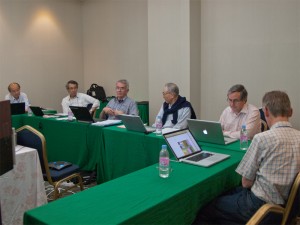During the past five years the physics and detector community has made much progress for establishing capable detector designs for the ILC. These achievements are to be summarised in the Detailed Baseline Design report (DBD) by the end of this year. The DBD will make a solid milestone, marking the end of the Letter-of-Intent period and the point for the community to proceed towards the next stage. We consider it a very important task to complete the DBD, and plans started already in 2010. As I wrote in January, discussions for a precise and detailed planning of the DBD started by the DBD format working group last year. The working group worked out basic structure of the volumes and a schedule towards completion. The minutes can be obtained in our web page.
The first step in the schedule was the preview of the planned outline of each chapter of the detector volume by the International Detector Advisory Group (IDAG). The detector groups prepared their plans of detector chapters last March, and they were handed to IDAG for advice together with the content of the introductory chapter. IDAG met during the ACFA KILC12 workshop in Daegu, Korea, last month. IDAG discussed with the management and the two detector groups SiD and ILD separately. It also heard from the software common task group about the status of the new simulations for 1-TeV benchmark reactions which are under way for the DBD, as well as from Michael Peskin about the studies for the physics volume.
IDAG gave me some recommendations in order to improve the content and style of the DBD and to make the drafting work smooth. They include points that help clarify the aim of DBD and make it more comprehensive. Also there were technically useful suggestions. I appreciate all the suggestions and adopt many of them since they strengthen our effort on DBD. I describe below some important points, backed up also by IDAG, which are meaningful to be known by the community.
First, IDAG confirmed that all contributors shared the basic stance that the expected audience of the document is high-energy physicists. We have been discussing the character of DBD with the concept groups for some time and agreed that the document should contain detailed enough information to convince our colleagues in the nearby fields about the feasibility and the capability of the designed detectors and about the clear discussions of physics reach. When the DBD is finished, however, it will also be desirable to address it towards wider communities including funding agencies. This will be made in collaboration with that of Global Design Effort by making separate volumes of an executive summary and an outreach document of both the Technical Design Report and the DBD combined.
The detector volume will have an introductory chapter, a common issue chapter and the two detector chapters. As suggested by IDAG, a common issue chapter will be made, in which common items will be moved from the introductory chapter and from each detector chapter. With the common issue chapter, the DBD can be organised in a clearer form, reducing duplications. Now detailed discussions are being continued by the DBD format working group on how to allocate the topics in order to make for smooth reading and comprehensive coverage.
An important recommendation about the common chapter was made regarding future R&D. It is always true that detectors can be improved as new technologies or studies develop. So the concept groups wish to continue further R&D, knowing where possible improvements can be expected. IDAG suggested a solution, which was the same as we had planned, that such future activities be placed in the common chapter, not in each detector chapter, so that we don’t give the impression that we are not ready. The detector part needs to present that capable detector systems can be realised based on the achieved technologies.
Taking the IDAG suggestion that the introduction be written earlier so that the detector authors know what has already been written in the introduction, we try to fix the contents and authors of the introductory and common issue chapters as soon as possible.
There were recommendations concerning the simulations. One of them is to put a summary of the existing simulation studies for 500-GeV reactions before presenting new benchmarks at 1 TeV. It is an important point in order not to confuse the readers. While the detector groups are now working in full swing to complete the new benchmarks, we should not forget that the primary focus of the TDR/DBD will be on achieving a robust design for 500-GeV physics and that a number of benchmarks were studied already for the Letters of Intent. This point was transmitted to the two detector groups.
The format working group will meet soon to finalise the plan so that we can go ahead soon with drafting. We will also consider making a short summary chapter after the individual detector chapters to bring a clear message to the readers. We wish to complete the DBD by stating in the summary chapter that the DBD describes the status of the ILC detector studies of the design groups, demonstrating that with the technology in hand we can conclude that the two baselines are feasible and capable of achieving the physics goals of the ILC, and that future work will now move us closer to realisation of these detector concepts.




Recent Comments